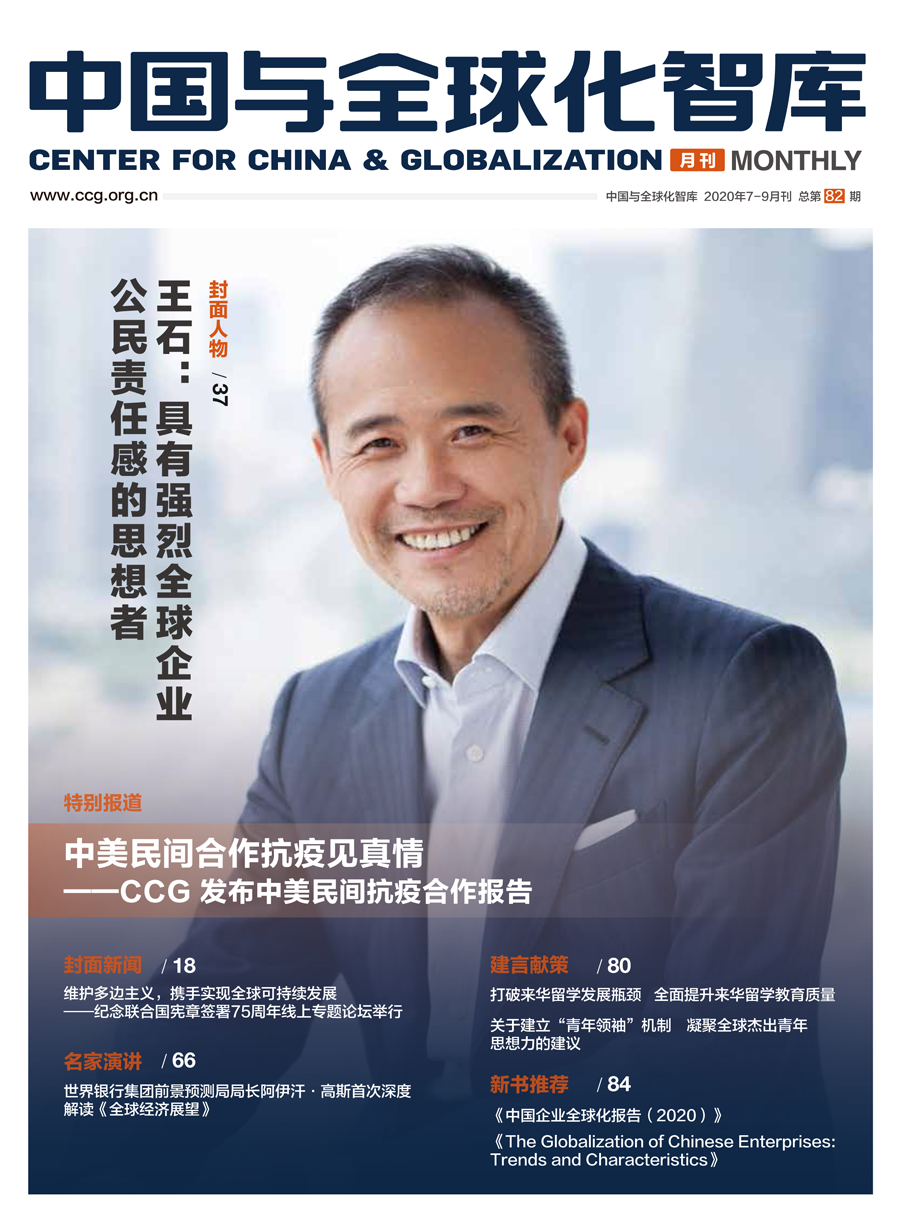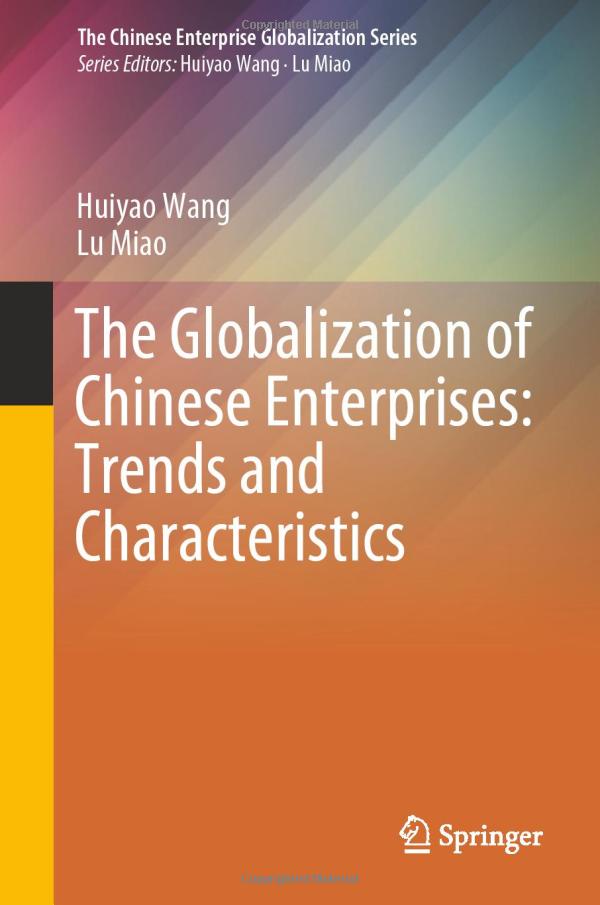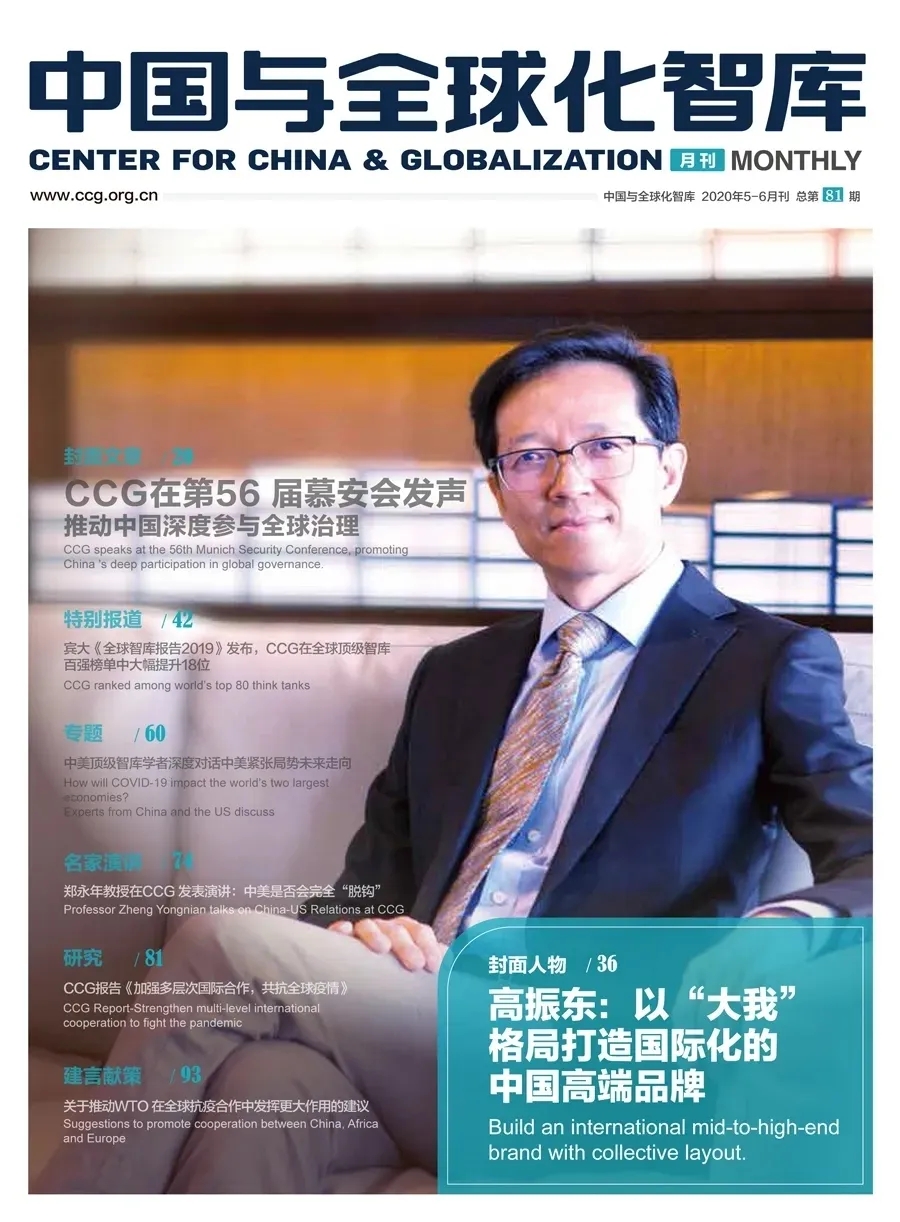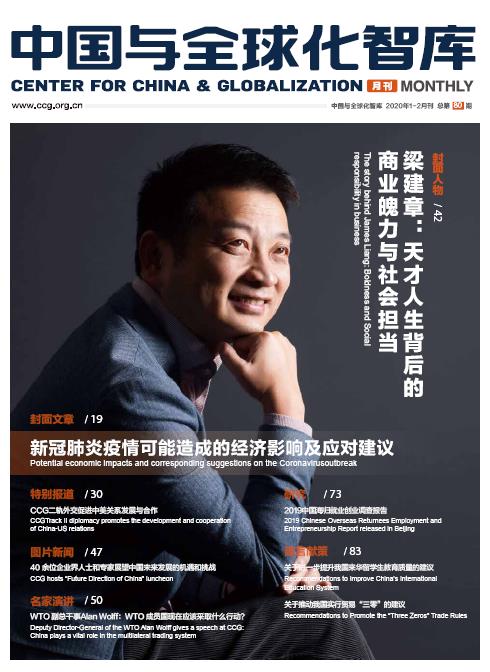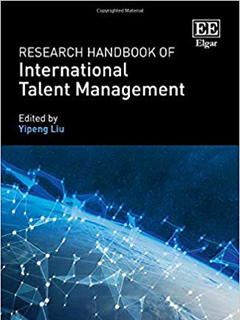Report on Chinese Enterprise Globalization(2018)

Publisher:
Author:
Release Date:
Click for Larger Picture
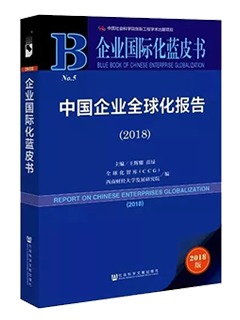
On
December 3, 2018, the Center for China and Globalization and the Development
Research Institute of Southwestern University of Finance and Economics jointly
released the 2018 Bluebook Report on Chinese Enterprise Globalization at CCG
Beijing Headquarters, which is published by the Social Sciences Academic Press
of the Chinese Academy of Social Sciences. This report was coauthored by CCG
and the Development Research Institute of Southwestern University of Finance
and Economics and edited by Dr. Wang Huiyao, CCG President and Dean of the
Development Research Institute of Southwestern University of Finance and
Economics, and Dr. Miao Lu, CCG’s Vice President and Secretary General.
The report summarizes the development and
characteristics of global foreign investment and Chinese companies’ outbound
investment from 2017 to 2018, and analyzes the reasons for the sharp decline in
their outbound investment from the perspective of international politics,
economy and investment environment, as well as proposes solution accordingly
for their reference. In addition, the report discusses the issues including
compliance with local regulations by Chinese companies in their overseas
development, private enterprises’ overseas investment in physical economy, and
economic and trade cooperation along the “Belt and Road”, the nature of Chinese
enterprises’ overseas development, the dilemma that Chinese SMEs are facing
abroad. Besides, the report invites professional lawyers to interpret the core
clauses of cross-border M&A transactions, analyzes the impact of recent
market access regulations in China, the US, and Europe on Chinese companies,
and propose 10 suggestions to stabilize the Sino-US relations amid their trade
conflict. Through the analysis and interpretation of eight cases studies about
Chinese enterprise going abroad and an audit of China’s outbound investment
activities from 2017 to 2018, the report provides more reference to guide
Chinese companies’ overseas development.
The report shows that the global economy
has entered into a stable recovery period in 2017, due to the factors such as
improved financial environment and increased market demand. According to data
from the International Monetary Fund (IMF), the world GDP growth rate in 2017
increased by 0.4 percentage points from 2016, the highest rate of global
economic growth since 2011. Despite heightened trade barriers and enhanced
de-globalization momentum, China’s economic development has a remarkable
performance. In 2017, China’s GDP reached 82.7 trillion yuan, exceeding 80
trillion yuan for the 1st time, an increase of 6.9% from
2016. Although Chinese companies have slowed the pace of investing abroad,
their outbound investment have gradually returned to a rational level in terms
of fields and modes.
In 2017, the global economy continued with
its recovery, but global foreign investment went on to decline, and even at the
highest level in nearly 15 years, exceeding the rate during the 2008-2009
financial crisis. Regionwise, the United States, Europe, and Asia are
still the most favorable destinations for investors. Sectorwise, the investment
is concentrated in the service industry. Regarding investment methods, both
cross-border M&A and greenfield investment have declined. Although trade
protectionism has been picking up globally, international investment policies
remain in support of investment freedom and facilitation. In 2017, Chinese
enterprises’ outbound investment dropped for the first time, while strengthen
regulations and supervision has guided Chinese companies to go global more
rationally. Thanks to the initiatives such as “the Belt and Road”, they were
able to invest in a broader range of areas and sectors. Currently, Europe, Asia
and North America remain the top destinations for Chinese investors, although
the investment in the United States has fallen sharply. M&A is still their
major approach for overseas investment. However, their greenfield investment
continues to decline. Among all the sectors, manufacturing continues to attract
most of Chinese overseas investment, while information and communications, IT
services and software industries are also gaining momentum.
Highlights
of CCG’s 2018 Bluebook Report on Chinese Enterprise Globalization
1. Global foreign direct investment from 2017 to 2018:
FDI has dropped again and taken the biggest decline since the financial crisis.
In 2017, global economy continued with its
recovery, but global FDI flow fell again. Unlike the slight decline in 2016, it
dropped 23% yoy in 2017 to about $1.43 trillion. According to CCG analysis, the
growing de-globalization trend worldwide is the main reason that caused the
sharp decline. For example, US President Trump’s protectionism policies has
increased uncertainties in global trade and economic cooperation. In Europe,
the elections of major states such as Germany and France reflect the expansion
of the right-wing forces in the region, which became a potential factor
hindering the globalization process. In addition, the US and European countries
have shown a strengthened investment protectionism tendency and formulated or
revise laws to provide a legal basis for the government to review foreign
M&A transactions.
investment in developed economies has dropped 37%, and Asia has surpassed
Europe to become the most popular investment destination again.
In 2017, global investment inflows to
developed economies shrank to only $712.4 billion, a decrease of $420.8 billion
or 37% from 2016. Global investment in transition economies also fell sharply
by 27% to $46.8 billion. In comparison, global investment in developing
economies remained stable and rebounded slightly by $500 million to $670.7
billion. Asia surpassed Europe to become the No. 1 destination of global FDI,
accounting for 36% of the total, followed by 26% in Europe, 21% in North
America, 10% in Latin America and the Caribbean, 4% in Oceania and 3% in
Africa. Compared to 2016, all the continents but Asia and Latin America and the
Caribbean have received less foreign direct investment to different degrees.
Europe, North America and Africa suffered from a sharp FDI decline by 39.8%,
39.4, and 21.5%, respectively. In 2017, the EU and Eurozone economy has begun
to recovery, growing 2.4% from the previous year. The global investment in Asia
has been growing steadily, with four out of the top 10 world’s most popular FDI
destinations coming from this region.
United States remains the world’s largest source of global FDI, and China has
become the largest FDI destination.
The US FDI has grown significantly in 2017,
up 22% year-on-year to reach $342.3 billion. Japan jumped from the 4th largest
source of FDI in 2016 to the 2nd in the world, reaching $160.4 billion. This is
the 4th consecutive year that Japan’s foreign investment has been on increase.
In mainland China, there has been a major decline of outbound investment in
2017, falling from $196.1 billion in 2016 to $124.6 billion. In terms of the
investment destinations, investment that flew to the US has decreased 40% last
year, although it is still ranked the No.1 destination with a total of $275.4
billion FDI. However, due to the US rigorous rules to review foreign investment
and other factors that created uncertainties, the global investment that flowed
to the country in the first half year in 2018 has fell by 73% to $46 billion,
making the US drop from the No. 1 FDI destination to the 3rd place. Under a
series of investment facilitation and investment promotion measures, China’s
attractiveness to foreign investment has been increasing. In the first half of
2018, China surpassed the United States and became the world’s largest foreign
investment destination.
FDI is equally focused on service and manufacturing industries, while
agriculture sector has lost steam.
In 2017, the primary industry led by
agriculture only received 1% of the total FDI, down 3% from 2016. Due to the a
large number of cross-border M&A cases in the chemical raw materials,
chemical product manufacturing, food and tobacco industries, manufacturing
industries accounted for 43% , 3% more than 2016. The service industry, on the
other hand, is still the most attractive sector for FDI, accounting for 56% of
the total investment. According to CCG analysis, many major economies have
introduced policies to boost industrial development and high-tech innovation in
recent years, such as Germany’s “Industry 4.0”, China’s “Made in
China 2025”, the United States’ “manufacturing backflow” and
Japan’s “new robot strategy”, to increase the global competitiveness
of their products. It has driven the FDI flow to global manufacturing
industries.
investment activities remain active but the number of large-scale deals has
slightly decreased; greenfield investment only increased in manufacturing
industry.
In 2017, the value of global cross-border
M&A cases have decreased by 22% year-on-year, while the number of M&A
deals increased slightly by 5% to 6,967. Among all, the deals in the primary
industry experienced a sharp decline by 123%. The value of greenfield investment
also dropped 14%. It is worth noting that in the greenfield investment in the
manufacturing industry grew 14%, while it decreased in both primary industry
and service industry by 61% and 25%, respectively.
global FDI policy is moving towards liberating and facilitating investment.
In 2017, a total of 126 policies have been
issued in 65 countries around the world about trade, and 73.8% of them are
intended to liberate and facilitate trade, 6% higher than 2016. The number of
policies to restrict foreign investment has slightly declined, accounting for
14% of the total. Asian emerging economies, in particular, are making
unprecedented efforts to expand the fields for FDI. According to CCG analysis,
the general trend is that many countries have attached more importance to
attracting FDI, and it has become a consensus to provide a more enabling
environment for foreign investors. However, there are still some countries that
are taking cautious approach to receive FDI in 2017. It is noteworthy that the
countries with restrict policies are mostly developed economies. They have
strengthened their review of foreign M&A deals, especially those that
involve strategic assets and high-tech companies. Given the fact that most
China’s outbound investment have flew to the developed economies in Europe and
North America last year, Chinese enterprises will be greatly affected by the
restricted review policies in those countries. Therefore, they are suggested to
be more prepared to handle the difficult situation with a more professional
M&A team.
2. China’s outbound Investment from 2017 to 2018
Chinese
enterprises’ outbound investment fell for the first time in 2017, but
strengthened policy supervision guided their investment abroad more rational.
According to data from the Ministry of
Commerce, China’s outbound investment have declined for the first time in
2017 to $158.29 billion. CCG believes that one of the reasons for the
decrease was the stricter policy supervision rolled out in the past two years
to guide Chinese companies going global. Policy changes have a significant
impact on their outbound investment.
Asia, and North America are major investment destinations; China’s investment
in the United States has decreased significantly.
In 2017, China’s outbound investment was
concentrated in Europe, Asia and North America, accounting for 39%, 23% and 23%
of the total, respectively. Countrywise, the investment in the United States
has dropped significantly both in terms of amount of value last year due to the
Trump trade policies and other factors that created uncertainties. Chinese
companies invested only 67 projects in the country, with a total $201.33
billion in value, a year-on-year decrease of 57% and 76% from 2016.
remains the major approach for China’s outbound investment, while greenfield
investment continues to decline.
According to CCG statistics, cross-border
M&A still dominated China’s outbound investment in 2017. However, the
number of M&A cases started decreasing, ending the time of the increase
both in the amount and value between 2013 and 2016. According to CCG analysis,
in 2017, the tightened policy and supervision has effectively curbed irrational
outbound investment, especially in the sectors like real estate, hotels,
entertainment. On the other hand, the barriers set by foreign governments in
cross-border M&A cases also discouraged Chinese companies’ outbound
investment.
Regarding greenfield investment, both the
number and value of the cases in 2017 have dropped to the lowest level in four
years after three-year continuous decline. CCG believes that greenfield
investment is beneficial to the social development, productivity and job
creation in the hosting countries. However, greenfield investment involves a
large amount of preparation work and a long term before the return on
investment starts, as well as the high requirement on the capital and
experience in localized operation. Therefore, it is still less favorable
compared to M&A investment. However, CCG predicts that as the “Belt and
Road” initiative will lead to the expansion of greenfield investment by Chinese
enterprises in the countries along the route in the next five years.
industry continues to be the focus on China’s outbound investment, while
information and communications, IT services and software industry are also
gaining momentum.
Sectorwise, manufacturing accounted for 40%
of China’s total outbound investment in 2017, 4% higher than the previous year.
The investment in information & communications, IT services and software
industry has grown for the 4th consecutive year in 2017, accounting
for 15% of the total, 4% higher than the previous year. CCG believes this
sector will gain more momentum with the increased M&A activities of Chinese
Internet giants such as Alibaba.com and Tencent Holdings.
CCG also points out that manufacturing is
still a key industry for Chinese companies’ outbound overseas. Through M&A
investment, they can acquire advanced technology and management experience,
transform and upgrade the entire industry, and optimize the allocation of the
domestic industrial structure. At the same time, through the M&A activities
in IT, computer services and software industries, Chinese companies have
acquired R&D, operation, management and technical talent in line with
international standard as well as established markets to continuously increase
their say in high-tech industries. However, they are advised to take cautious
measures when conducting M&A in these fields, with the national security
review and anti-monopoly review in the developed countries.
and Road” initiative expands economic and trade cooperation and widens fields
for China’s outbound investment.
In the first half of 2002~2018, in terms of
scale, most investment by Chinese companies in the Belt and Road countries are
between $100 million to $1 billion, accounting for 48.7% of the total,
following by the investment between $10 million and $100 million and the
investment between $1 billion and $10 billion, accounting for 25% and 15.6%,
respectively. The cases of the investment below $100,000 and above $10 billion
is very limited. Sectorwise, most of the investment in the Belt and Road
countries flew to manufacturing and information/communications/IT
services/software industry, accounting for 33% and 34%, respectively, followed
by mining, transportation, and financial industries, all accounting for 7%. The
rest of the shares scattered in the industries like real estate, construction,
culture & sport, electricity, and gas and water supply.
According to CCG analysis, after five years
since its release, the “Belt and Road” initiative has entered the stage of
comprehensive cooperation. China’s state-owned enterprises, as the main force
in outbound investment, have driven the cooperation and development in the
industries like infrastructure, energy, and aviation the countries along the
route. At the same time, because of the PPP projects promoted by the Chinese
government, many private companies have been able to participate in the
upstream and downstream of industrial chains built along the “Belt and Road”,
and more companies in manufacturing and IT industries introduced to the markets
in the region. Overseas industrial parks have become an effective path and
platform for the construction of the “Belt and Road” projects.
3. Five major challenges and solutions accordingly for
Chinese enterprise globalization in 2017~2018
companies going abroad needs to improve their compliance with international
standards.
Many Chinese companies have been punished
abroad because they were not familiar with the laws and regulations of the
hosting countries or had no a complete compliance system to avoid legal risks.
CCG recommends the Chinese enterprises to raise their awareness and attention
to compliance from the top leadership, to improve their compliance system and
to appoint chief compliance officer to coordinate on the relevant affairs. The
government is advised to strengthen legislation for the compliance of Chinese
companies and establish a specific commission to review their practice. In
addition, think tanks can provide advice and suggestions to help Chinese
companies abroad in this regard.
companies still have a long way to go from selling products abroad to
establishing brands abroad.
Chinese companies are still lagged behind
developed countries in terms of their branding influence. According to CCG
analysis, this is because Chinese companies are still caught in traditional
business thinking, and their brand reputation, promotion, and management needs
to be improved. To solve these problems, Chinese enterprises should enhance
their product quality and improve R&D with both the essence of Chinese
traditional culture and lesson learned from the best practice in overseas
management and consumption culture. The government should improve policies and
regulations to create a favorable environment and create more opportunities for
Chinese brands to go abroad. Media, on the other hand, should also help Chinese
companies build their brands abroad.
companies involved in the “Belt and Road” initiative have encountered
difficulties in their overseas investment.
Chinese enterprises have played a vital
role in the “Belt and Road” initiative. However, as they became more involved
in the “Belt and Road” projects, they started encountering various
difficulties, including political risks, cultural barriers, differences in
legal systems, and environmental and labor issues. CCG believes that those
problems were caused by the frequent regime changes in countries along the
route, investment barriers created by cultural conflicts, and environmental
issues that hinder the further development of their overseas investment. CCG
suggests the companies to learn more about how to use political insurance tools
and improve their compliance with local regulations on business operation. The
government is advised to help enterprises to participate in overseas investment
negotiations, break down the obstacles for the sake of common interests,
and invite developed countries to join the “Belt and Road” projects.
Meanwhile, financial institutions are pushed to provide them with more
assistance.
companies’ investment in the U.S suffered setback.
The ongoing Sino-US trade friction is a
heavy blow to Chinese and American companies. According to CCG analysis, the
reasons for such as a predicament include American bipartisan politics, the US
political game in the name of protecting “national security”, and the
lack of social responsibilities for some Chinese enterprises in the United
States. To improve the situation, CCG suggests that Chinese companies should
adapt themselves to American social culture and fulfill their social
responsibilities to gain more support. At the same time, they should explore
more investment opportunities in the emerging countries in Asia, Africa and
Latin America. The government should provide them with more policy support to
go abroad and maintain multilateral and free trading mechanisms. Financial
institutions such as banks should also increase capital support for Chinese
companies. General public should restore confidence in the home-grown
companies. Think tanks should actively promote “Track II Diplomacy” to help
create a favorable environment for Chinese companies abroad.
PPP efficiency needs to improve for Chinese enterprises’ contracting projects
abroad.
At present, the level of
internationalization of Chinese companies that contract construction projects
abroad is still relatively low, far behind developed countries. Chinese
companies are still in a primitive stage in the business of overseas project
contracting and therefore facing many challenges. CCG believes that Chinese
companies needs to improve the capacity of running PPP projects overseas and to
handle the challenge from the lack of PPP-related regulations and policies in
the hosting countries. As a solution, CCG suggests that Chinese companies
change their mentality when participating in PPP projects and select the best
timing and method to launch the cooperation. The government can promote PPP
cooperation in the countries that have closer relations with China and provide
information platform to help Chinese companies go abroad and coordinate on
their overseas contracting projects.
